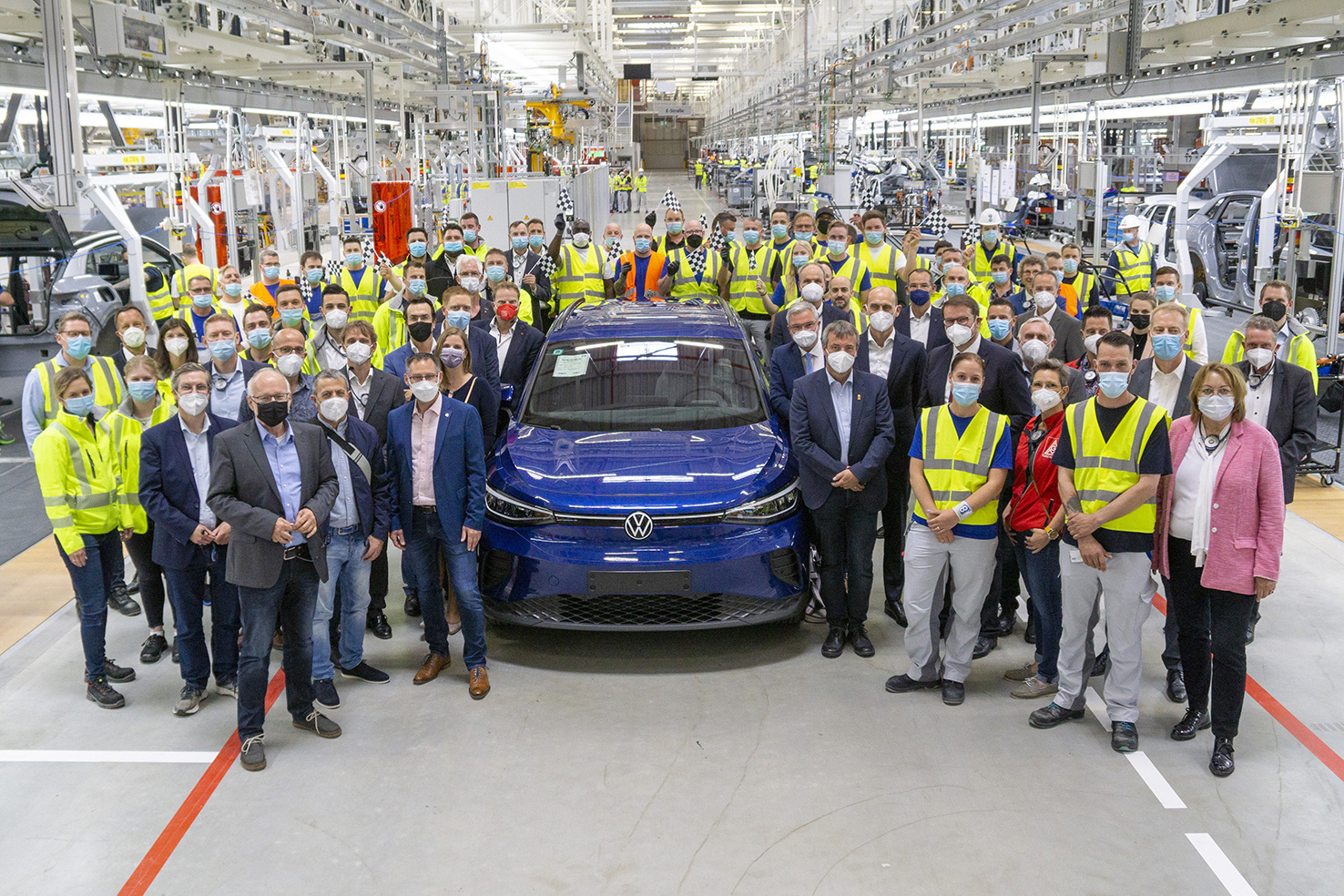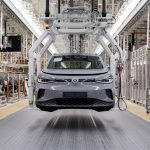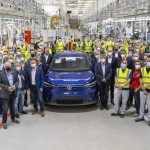

News
Volkswagen launches new factory to expand electric vehicle production network
Volkswagen announced on Friday that it had officially started production of the ID.4 all-electric crossover at a new facility in Emden, Germany. The plant is the newest electric vehicle manufacturing facility for Volkswagen and is another step in the automaker’s plan to expand its global manufacturing footprint for electric vehicles.
On Friday, Volkswagen said it was pressing ahead with its plans to transition to electric mobility by expanding its global production network. The expansion was marked with the start of ID.4 production at its new site in Emden, Volkswagen’s second facility for manufacturing electric vehicles in Germany following its Zwickau plant.
Volkswagen’s Emden Plant (Credit: Volkswagen)
Volkswagen said it will also launch production of EVs at two other facilities this year, one in Chattanooga, Tennessee in the United States, and another in Hanover, Germany. The plants will contribute to an annual electric vehicle production capacity of 1.2 million vehicles. With three new plants opening in 2022 for Volkswagen, brand CEO Ralf Brandstätter said the clear cut strategy for growth relies on more facilities on a global scale.
“Rapid expansion of production capacities for our successful ID.4 model is a key component of our ACCELERATE strategy,” Brandstätter said. “It helps us accelerate the transformation to zero-carbon mobility and create further capacities to meet the high demand for electric vehicles. With our clear commitment to the site, we aim to show that cost-effectiveness and competitiveness are not only possible in the region, but that we can even enhance them lastingly.”
- One of the first ID.4 to be built on the assembly line in Emden.
- Start der Produktion des ID.4 in Emden.
- Start der Produktion des ID.4 in Emden.
Lower Saxony is becoming a hotspot for Volkswagen’s EV production expansion. The company already employs 130,000 people in the area. The new Emden plant will build the ID.4, but next year the plant will build the AERO B, another all-electric vehicle from the German company. Additionally, production of the ID.Buzz will also commence in Hanover but will be joined from 2023 on by the ID.3 made in Wolfsburg.
Volkswagen said six new production halls and five new conveyor bridges and logistics buildings have been created as a part of Emden’s transformation into an electric vehicle manufacturing plant. The automaker focused on successful training near production lines and in a virtual setting, which helped employees transition to the new products.
Volkswagen is converting another German plant for EV production
As far as the ID.4, it is now produced at Emden and Zwickau in Germany and Anting and Foshan in China, meaning four facilities have been given space for manufacturing the all-electric vehicle. The vehicle will also be built at the Chattanooga factory in the fall. The ID.4 has quickly become Volkswagen’s most successful EV with more than 30,000 units delivered in 2022’s first quarter. Half of all VW’s EV deliveries are an ID.4, as the automaker has delivered 163,000 units of the vehicle since its launch early last year.
I’d love to hear from you! If you have any comments, concerns, or questions, please email me at joey@teslarati.com. You can also reach me on Twitter @KlenderJoey, or if you have news tips, you can email us at tips@teslarati.com.

News
Tesla China quietly posts Robotaxi-related job listing
Tesla China is currently seeking a Low Voltage Electrical Engineer to work on circuit board design for the company’s autonomous vehicles.

Tesla has posted a new job listing in Shanghai explicitly tied to its Robotaxi program, fueling speculation that the company is preparing to launch its dedicated autonomous ride-hailing service in China.
As noted in the listing, Tesla China is currently seeking a Low Voltage Electrical Engineer to work on circuit board design for the company’s autonomous vehicles.
Robotaxi-specific role
The listing, which was shared on social media platform X by industry watcher @tslaming, suggested that Tesla China is looking to fill the role urgently. The job listing itself specifically mentions that the person hired for the role will be working on the Low Voltage Hardware team, which would design the circuit boards that would serve as the nervous system of the Robotaxi.
Key tasks for the role, as indicated in the job listing, include collaboration with PCB layout, firmware, mechanical, program management, and validation teams, among other responsibilities. The role is based in Shanghai.
China Robotaxi launch
China represents a massive potential market for robotaxis, with its dense urban centers and supportive policies in select cities. Tesla has limited permission to roll out FSD in the country, though despite this, its vehicles have been hailed as among the best in the market when it comes to autonomous features. So far, at least, it appears that China supports Tesla’s FSD and Robotaxi rollout.
This was hinted at in November, when Tesla brought the Cybercab to the 8th China International Import Expo (CIIE) in Shanghai, marking the first time that the autonomous two-seater was brought to the Asia-Pacific region. The vehicle, despite not having a release date in China, received a significant amount of interest among the event’s attendees.
Elon Musk
Elon Musk and Tesla AI Director share insights after empty driver seat Robotaxi rides
The executives’ unoccupied tests hint at the rapid progress of Tesla’s unsupervised Robotaxi efforts.

Tesla CEO Elon Musk and AI Director Ashok Elluswamy celebrated Christmas Eve by sharing personal experiences with Robotaxi vehicles that had no safety monitor or occupant in the driver’s seat. Musk described the system’s “perfect driving” around Austin, while Elluswamy posted video from the back seat, calling it “an amazing experience.”
The executives’ unoccupied tests hint at the rapid progress of Tesla’s unsupervised Robotaxi efforts.
Elon and Ashok’s firsthand Robotaxi insights
Prior to Musk and the Tesla AI Director’s posts, sightings of unmanned Teslas navigating public roads were widely shared on social media. One such vehicle was spotted in Austin, Texas, which Elon Musk acknowleged by stating that “Testing is underway with no occupants in the car.”
Based on his Christmas Eve post, Musk seemed to have tested an unmanned Tesla himself. “A Tesla with no safety monitor in the car and me sitting in the passenger seat took me all around Austin on Sunday with perfect driving,” Musk wrote in his post.
Elluswamy responded with a 2-minute video showing himself in the rear of an unmanned Tesla. The video featured the vehicle’s empty front seats, as well as its smooth handling through real-world traffic. He captioned his video with the words, “It’s an amazing experience!”
Towards Unsupervised operations
During an xAI Hackathon earlier this month, Elon Musk mentioned that Tesla owed be removing Safety Monitors from its Robotaxis in Austin in just three weeks. “Unsupervised is pretty much solved at this point. So there will be Tesla Robotaxis operating in Austin with no one in them. Not even anyone in the passenger seat in about three weeks,” he said. Musk echoed similar estimates at the 2025 Annual Shareholder Meeting and the Q3 2025 earnings call.
Considering the insights that were posted Musk and Elluswamy, it does appear that Tesla is working hard towards operating its Robotaxis with no safety monitors. This is quite impressive considering that the service was launched just earlier this year.
Elon Musk
Starlink passes 9 million active customers just weeks after hitting 8 million
The milestone highlights the accelerating growth of Starlink, which has now been adding over 20,000 new users per day.

SpaceX’s Starlink satellite internet service has continued its rapid global expansion, surpassing 9 million active customers just weeks after crossing the 8 million mark.
The milestone highlights the accelerating growth of Starlink, which has now been adding over 20,000 new users per day.
9 million customers
In a post on X, SpaceX stated that Starlink now serves over 9 million active users across 155 countries, territories, and markets. The company reached 8 million customers in early November, meaning it added roughly 1 million subscribers in under seven weeks, or about 21,275 new users on average per day.
“Starlink is connecting more than 9M active customers with high-speed internet across 155 countries, territories, and many other markets,” Starlink wrote in a post on its official X account. SpaceX President Gwynne Shotwell also celebrated the milestone on X. “A huge thank you to all of our customers and congrats to the Starlink team for such an incredible product,” she wrote.
That growth rate reflects both rising demand for broadband in underserved regions and Starlink’s expanding satellite constellation, which now includes more than 9,000 low-Earth-orbit satellites designed to deliver high-speed, low-latency internet worldwide.
Starlink’s momentum
Starlink’s momentum has been building up. SpaceX reported 4.6 million Starlink customers in December 2024, followed by 7 million by August 2025, and 8 million customers in November. Independent data also suggests Starlink usage is rising sharply, with Cloudflare reporting that global web traffic from Starlink users more than doubled in 2025, as noted in an Insider report.
Starlink’s momentum is increasingly tied to SpaceX’s broader financial outlook. Elon Musk has said the satellite network is “by far” the company’s largest revenue driver, and reports suggest SpaceX may be positioning itself for an initial public offering as soon as next year, with valuations estimated as high as $1.5 trillion. Musk has also suggested in the past that Starlink could have its own IPO in the future.











